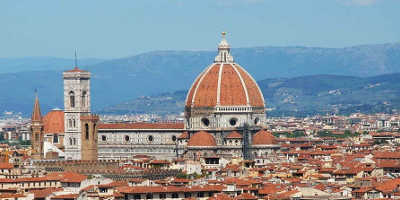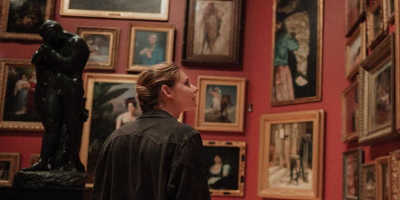Accademia Gallery (Galleria dell'Accademia), Florence
‘Accademia dell’Arte del Disegno’ aka ‘Gallery of the Academy’ is one of the world’s most well-known museums in Florence that is brimming with priceless aesthetic masterpieces.
Founded in 1784, this museum is renowned for housing treasured works of Renaissance art and sculpture that have marked mankind’s artistic innovation through centuries. From Michelangelo’s David to Sandro Botticelli’s Birth of Venus, the masterworks created by the greatest minds of all time adorn this world-class gallery. We’ve got the groundwork done so you can have an amazing tour at the Galleria dell’Accademia.
Masterpieces at the Accademia Gallery
-
Symbol of Florence: Michelangelo’s original ‘David’
Tourists flock to the Accademia to see Renaissance’s much-celebrated masterwork, Michelangelo’s magnum opus: David. Nothing quite compares to seeing incredibly magnificent 17 feet tall statue carved out of a solid block of gleaming white marble standing under the flattering light of skylight in all its glory. What’s more? From the veins in his sinewy arms to impeccable changes in expression as you move around the statue, this anatomically realistic marvel epitomizes the creativity that existed in Florence during the Renaissance.
-
Hall of Prisoners
The Hall of Prisoners houses four extraordinary unfinished statues of ‘slave’s by the famous artist Michelangelo, forming an entrance hallway to the sculpture of David. The stunning semi-sculpted male figures depict their struggle to clamber out from the physical bonds and colossal weight of the marble. Also, the hall boasts of the walls decorated with anthropomorphic figures immaculately carved from sponges, stones, and shells to complement the sculptures of the slaves.
-
The Musical Instrument Museum
This section of the Accademia hosts the Grand Ducal Collection of forty musical instruments from the 16th century in their original splendor. From the elegant string and wind instruments to the one-of-a-kind tenor viola, the Musical Instrument Museum is heaven for connoisseurs of music. The experience becomes more immersive because you can hear the sounds of the instruments as you learn their history.
-
Giambologna’s ‘Rape of the Sabines’
Carved from a single block of stone, the three-person, towering depiction of the Rape of the Sabine Women is considered one of the best sculptures in the world. Giambologna carved this plaster model to prepare for the final marble piece that now stands in the Piazza della Signoria in Florence. Since marble was such an expensive material, artists created practise models from cheaper materials such as plaster. Though it is not the finished piece, the model housed in the Accademia is more highly prized by many since the artist himself created it, whereas multiple artists would have created the final marble piece.
The statue represents the story of the Rape of the Sabines, the ancient tale from the founding of Rome when the Roman men looked for more women to increase their population. After failed negotiations with the Sabines, the Roman men created a distraction for the Sabine men whilst they abducted their women.
-
Botticelli’s ‘Madonna of the Sea’
Though listed as a work by Botticelli, there is controversy over whether he is the true artist. The Renaissance painting was discovered in the convent of Santa Felicita in Florence and after restoration it was decided that it was a part of Botticelli’s output of work. The use of brushwork has cast a cloud of doubt over the identity of the artist, but due to the Virgin Mary subject matter, a popular theme for Botticelli, it has remained under his name.
Botticelli loved to use symbolism in his paintings and the Madonna of the Sea is no different. The painting is so-called because of the background scene of the sea and the Stella Maris (star of the sea) shown on the Virgin’s clothing. The child in the image is holding a pomegranate which refers to Christ’s passion, his future suffering, and we can find the use of this fruit in other works by Botticelli.
-
Pietro Perugino’s ‘Assumption of the Virgin’
Hanging in the hall of Colossus, close to Giambologna’s plaster model, is the large altarpiece that was commissioned by the monks of the Abbey in Vallombrosa in 1500. The Assumption of the Virgin is one of Perugrino’s most outstanding creations. Within the painting, the Virgin Mary is surrounded by joyous angels, singing and playing, while four saints stand below her.
Either side of the Perugino’s painting are two others worthy of note: Filippino Lippi’s ‘Deposition’ and Raffaellino’s Del Garbo’s ‘Resurrection’.
-
Cassone Adimari
Originally thought to have been made for the front panel of a wedding chest, the Casson Adimari shows the marriage between Boccaccio Adimari and Lisa Ricasoli. The painting was created around the year 1450 and depicts an elegant wedding parade taking place in Florence. As the noblemen and noblewomen walk beneath a colourful, draped awning, the buildings of Florence stand proudly in the background. The elegant green and white façade of the Baptistry of St. John the Baptist is one of the most recognisable buildings in the image. Around the main parade, musicians play happily, and servants carry items into a house. Notice the beautiful details applied to the garments of the figures, showing what the fashion of the wealthy would have been like during this period.
Tips to visit the Accademia Gallery
Pro tip: It’s a great idea to book the tickets in advance to avoid queuing during the summer tourist season.
Opening hours: 8:15a.m.-6: 50 p.m.; Tuesday through Sunday; closed every Monday, January 1, May 1and December 25.
Tickets: €2.00-€12.00









